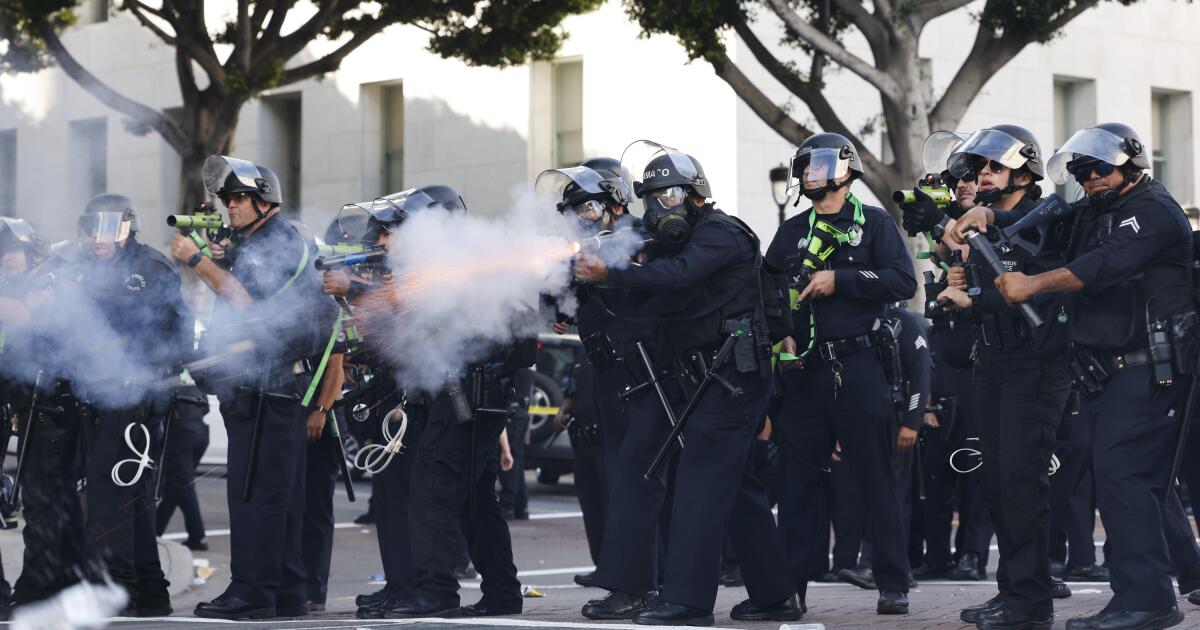L.A. City Council votes against ban on police ‘less-lethal’ launchers
The Los Angeles City Council voted against a proposal on Tuesday that would have prohibited police from using weapons that launch hard-foam projectiles and tear gas, amid lingering concerns about their deployment at protests last summer.
After hearing arguments from both sides, the council decided against approving the proposal 8 to 4, with three council members absent.
Addressing his colleagues on Tuesday, ordinance backer Hugo Soto-Martinez said he felt extra restrictions were justified because Los Angeles Police Department officers seemed to be deploying the weapons in ways that violated state law, court orders and the department’s own policies.
Videos from the protests over the federal immigration crackdown that roiled the city last summer revealed “documented verified evidence of military equipment being used in ways that should make everyone on this body pause,” he said.
He noted how on one day alone in early June, LAPD officers fired more than 1,000 foam projectiles — appearing to fire indiscriminately into crowds of protesters with weapons that are meant to target specific individuals.
“Our residents should be able to express their rights without being met with rubber bullets or tear gas,” he said.
LAPD policies are set by the Police Commission, a five-member civilian body. Outside of approving the department’s annual budget, the council’s oversight of the LAPD is limited.
But council members sign off on the department’s yearly reports on the acquisition and use of anything that is considered military equipment under state law. The use of such items — including high-powered rifles, drones, explosives and long-range acoustic devices — has come under increased scrutiny in recent years, with critics arguing it fuels more aggressive policing on the streets of many U.S. cities.
The defeated proposal sought to bar the LAPD’s use of two types of military weapons — tear gas and so-called 40-millimeter less-lethal launchers — at protests, but also for everyday patrols and other special events.
Councilmember John Lee said he was concerned that taking away such weapons would lead to more use of deadly force.
LAPD Chief Jim McDonnell said he found it “amazing that we would be entertaining this,” pointing out that the 40-millimeter launchers are used by officers every day to defuse encounters with uncooperative and violent suspects.
He offered to show council members videos of the chaotic situations in which officers used the weapons. He also pointed out that the department polices hundreds of protests every year that don’t involve officers firing less-lethal launchers. The devices fire projectiles roughly the size of a mini soda can at speeds of more than 200 mph.
“Taking a tool like that away from us puts us in a really bad position,” McDonnell said. He said that the use of tear gas during a mass demonstration in June was only authorized after “violent” protesters began creating barriers and firing “industrial-grade” fireworks at officers.
“It is truly a de-escalation tool,” McDonnell said. “To me this is incredibly uninformed public policy, to go down this road.”
The meeting turned tense at times, particularly when Councilmember Eunisses Hernandez pressed McDonnell about his department’s response to the protests.
McDonnell repeatedly interrupted to say that the hard-foam projectile launchers allow officers to avoid the use of more dangerous weapons, and invited Hernandez to become educated on the weapons firsthand before she voted.
“I would say it’s a crowd-control tool, not a de-escalation tool,” Hernandez said. She also took exception to McDonnell calling the LAPD a “model” for other departments, pointing to the massive legal payouts that the city has had to cough up for police excessive force and other misconduct.
“You’re trying to put a price on saving lives,” McDonnell shot back.
The use of police weapons designed to subdue rather than kill has also been challenged in court. In September, a federal judge extended restrictions that prohibit federal Homeland Security agents and LAPD officers from using less-lethal weapons against peaceful protesters and journalists.
Critics say the term “less lethal” is misleading, since such weapons have resulted in deaths and millions of dollars in legal settlements to people who sued after they were seriously injured from being hit in the head or groin.
